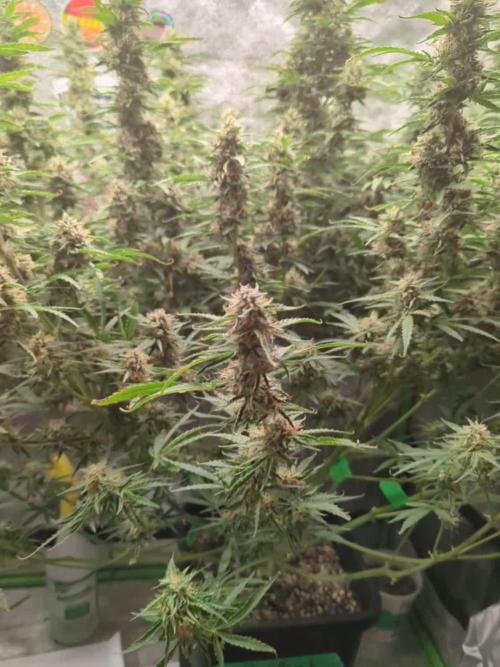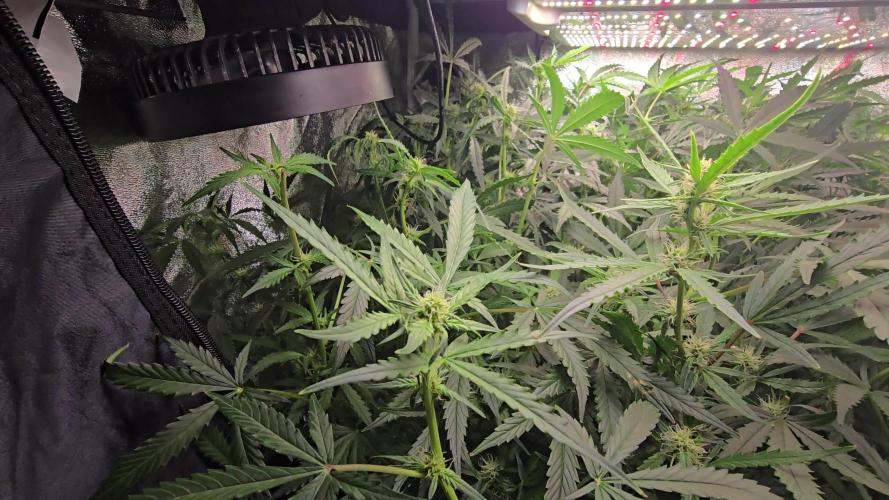The Grow Awards 2026 🏆 





























Likes
Comments
Share


@RCUgrows
Follow
I love this plant. It's such a beautiful structure. Buds are fattening up really well. Seeds are also starting to be produced. Looks like the rest of the plant has become pollinated. Couldn't be happier.
Likes
17
Share


@gottagrowsometime
Follow
Runtz Fem (mother) is on week 8. It's been a somewhat slow grow. But, I've been able to make a perfect pheno that changed early into a bigger pot does have fast growth for this pheno. It's strong. Hardy & quick to recover & nor easily affected by any issues. These are the perfect traits for my test. It's not about yield. It's about having a quality flower producing pheno. Which I can put 2 clones thar come off the same node set (pair) and are even as clones in appearance & more importantly as genes you can test with in this setting.
Week 8 Days 48-53
Day 50, she's ready to be cloned. She'll get 6 hrs of rest. I'll remove the clones and treat them in clonex with rockwool cubes. Have made a humidity dome as I can find the ones I bought years ago. But this will do till rooted in 4-7 days.
Day 51
Day 2 clones have survived and going strong at 36hrs later you see they're doing well behind a big pot in my tent (more or less ambient light with a bottle keeping up high RH above 85%. Refreshing air everyday). Keeping my eye on the wool to make sure everything keeps moist.
Will be putting both fully rooted clones into 7L pots of exact same mix of Promix soil & using the Terra line from plagron with power roots & Startup (which was gifted by my grow store). Only plagron will be used in these phenos. The mother will remain on Xpert Nutrients and not be given green sensation aswel ad 1 of the 7L clone pots obviously. 3 phenos of the same in all.
1 Xpert Nutrients (full line)
1 Full Plagron (with) Green Sensation
1 Full Plagron (without) Green Sensation
3 phenos 1 mother. 3 different results.
Let the fun begin.
DISCOUNT CODES
20% off XPERT NUTRIENTS & KANNABIA with code: GGST
20% off Oringal Sensible Seeds with code:
GGSTGD
20% off Zamnesias entire catalogue of seeds with code: ZAMMIGROW2024
Likes
10
Share


@RedbeardGrow
Follow
A metà settimana la pianta è in continuo progresso, i fiori si gonfiano adeguatamente, la cima sta maturando a vista d'occhio. Monitorerò il comportamento dei fiori ed il colore dei Tricomi. Attendo la fine della settimana per mostrare gli ulteriori progressi.
Processing
Likes
29
Share


@ChiefGrowAutoflowers
Follow
Hey guys it’s week three and I’m feeling great. I ran into a few issues:
1. Unexpected rise in humidity.
Don’t really know why it spiked but I purchased a dehumidifier to combat the issue.
2. White powdery Mold on the side of my grow fabric pots.
I believe this was a byproduct of my humidity issue. I heavy inspected each plant and from the surface everything appears to be ok. I whipped away the mold and spray it down with a solution I made from mouth wash and water prior to the girls going to sleep. I also added another fan to add more circulation.
3. I took a few photos of some of my leaves there looks to be some discoloration hard to tell what it is due to me being color blind, I believe this is due to nutrition burn. All please take a look and tell me what you think it is, is it one problem or multiple?
Other than that I started LST, great start so far I believe!
Likes
18
Share


@Wicked_Stix
Follow
Was a pretty smooth week for most the girls. Showing some steady growth. I topped all of the plants around day 12 other than the slurricane 7. Ph got a little high since the nutrient level was too low to buffer it at the beginning of the week. Slurricane 7 and sugar cane are the ones that took some damage. I think they will be ok though. I upped the nutrients to 1/4 tsp per gallon and the ph has held stable since then. Should be able to start some training the middle of next week and looks like we might be going 2 more weeks on veg before flipping them to flower depending on how this upcoming week goes. Guess you will have to show up next week to find out...
Likes
15
Share


@DRO420
Follow
This week I put up a long video that features my new tent and new clones from these current clones that are flowing.
The hairs are turning color now and I have given them there last feeding, only straight ph balanced water from here on out to flush the plants so they taste nice.
Likes
37
Share


@PapaNugs
Follow
Another good week come and gone. A couple of the girls needed nutrients so I add some general hydroponics blend into those that needed them. Didn't seem to make much difference yet. But they are getting into late flower.
Orange sherbet isnt great right now. No real smell and not looking great. Not sure but prolly too small of a pot.
Dimmed to 80%
Here are the lights details:
Medic Grow Mini Sun-2 150W LED
Model: MN150-022
Spectrum mode: V1
Efficacy: 2.8 umol/J
Thanks for stopping by!
You can find the light on Grow Diaries:
https://growdiaries.com/grow-lights/medic-grow/mini-sun-2-150-watts
You can find the light on Medic Grow's website:
https://medicgrow.com/
Likes
3
Share


@Andres
Follow
my other tent was small. She went through stress twice because of my dog. He dug up the roots but she survived. looks strong and healthy.
Likes
44
Share


@Buffynuffy
Follow
It’s amazing watching these plants grow, it’s been an experience already and so much to go with this grow and with all the learning to come I hope it looks okay to you guys anyone who would like to comment please do I’d love to hear other’s thoughts!
Processing
Likes
7
Share


@DigitalJockeyKing
Follow
got bitten by a spider and realized i was always wondering what my spiritual animal was, and realized it was spiders after that awakening of asking mother natures help me and spiders made a blood pack and since then nature has been helping me out by protecting my plants, from thieves and bad rotten people. and nature gave me spiders to protect my children. one of my spiders thats protecting the rooibaard is called GREGGK.
Likes
11
Share


@Madman2020
Follow
Day 12
Starting to show preflowers. Seems a bit late.
I will take clones today from top 3 plants
81f/76%.
1100ppm.
1000co2 37-53kluxx
4 very sickly and ugly plants
Plant stems are all pretty stiff by now.
Looks like i could have fit 2 more plants
Day 14
Plants are doing well with height control.
I did a second Topping of the main 4 branches for each plant the week before flower flip.
Most plants are 22-25inches tall
3 of my White Weddings are looking very weird. Not a clue as to what is wrong.
Flowers are developing well on each plant
No more LST from here in out. I will let them grow how they are(minimal stress)
Started Defoliating
Likes
11
Share


@Lucidgrower09
Follow
Hey guys this is week 1 in flower for the fat banana. She is growing good now so i think she will become double the size she was before flower. I defoliated her because i don't wanna give her stress later in the flower periode. She gets water every 2 days she is drinking good we gave her callmag pro, sugar royal,power buds and alga bloom from plagron. Its a strong strain ive got no problems so far so lets hope it stays that way😅. Follow me on instagram for mor pictures and videos. Take care and until next week ✌️
Likes
21
Share


@BushDoctor740
Follow
Day 70 Well I think I will give them another week and harvest.Showing lots of trichomes that are mostly cloudy so I’ll let them go a bit longer.The tallest girl is at 40 inches and suffered some fox tailing I’m gonna say from when I pounded them with light for a week or so 😆.Even though she fox tailed and will not have the most dense buds she smells super strong and loaded with trichomes.Of the 5 Runtz the shortest has the chunkiest most dense buds.The other 3 were very big producers and took the LST great branching out forming tons of colas.Ill try to let them dry out this week and place in the dark for a day or so before chopping.Unfortunately in my area we have heavy rains all week humidity may become a problem so I will add a dehumidifier soon.
Likes
16
Share


@GrowerGaz
Follow
Just water as they are very small , light is a 100w Samsung led light for the first week then I will switch to the Zeus 465w Compact pro.
I have repotted the plants now the seeds have popped, they are in 2 litre pots now. As soon as the toots hot the bottom of the pots I will put them in my autopots system.
I have tried adding a layer of perlite on top of the bAc soil. To try and stop any bugs getting into my soil and also reflect the light back.
Processing
Likes
5
Share


@Ganjagrandaddy
Follow
DAY 49: This lady has took me round the houses this week. She was looking so close to her finishing with so many browning pistils . Thankfully she has now begun her second flush of flowering all over. Her buds look to be swelling a little more now and she is smelling so fruity sweet still. Her ge.eral health is good and she doesn't have any fade going on anywhere from maturity either. She does have so endive sized colas around her now too so another couple of weeks could give her chance to swell more. I have committed the cardinal sin of nipping odd a lower limb to dry and sample her at this point. 7 weeks and she is looking good already. I do think the second flush of flowering will allow me to keep her going a few more weeks as I think she is a beautiful cross. Her smell is really nice and sweet with a definite creamy after thought. I do have a few more of her mums seeds so will see how they fare in a scrog I think are some point. I am so far , very happy that I germed this to try and am Looking forward to sampling it cured.






























